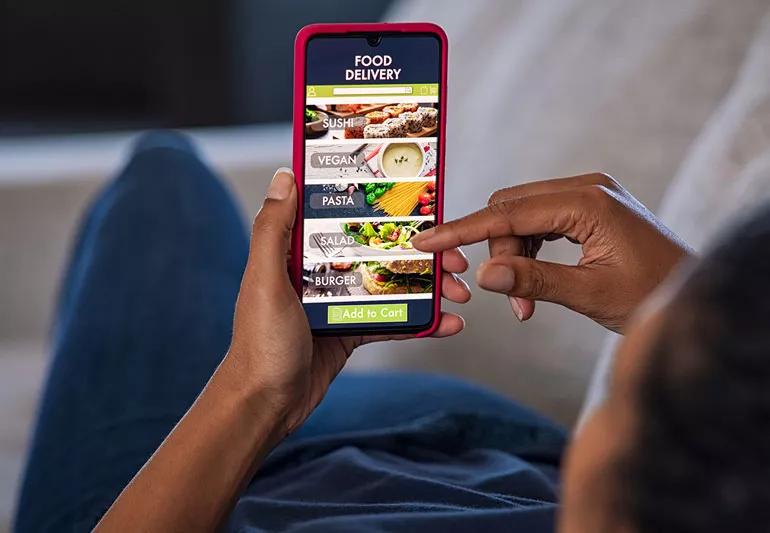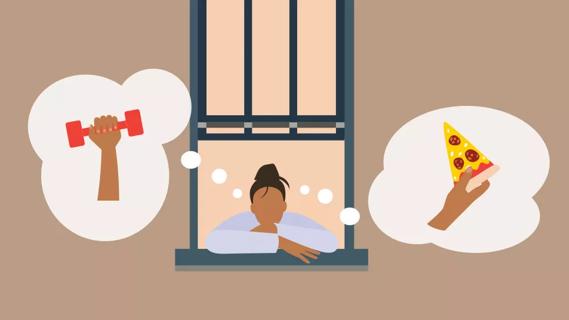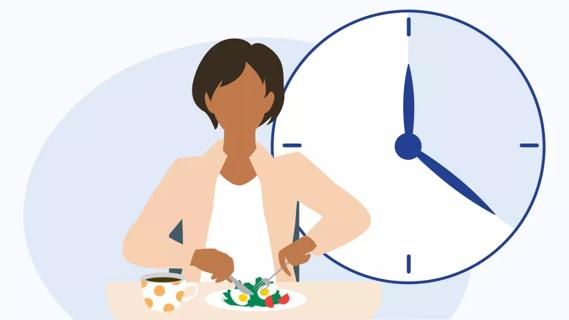Be mindful, like gauging your hunger and reviewing nutritional information

Tell us if this sounds familiar: It’s dinnertime and you don’t feel like cooking. You open a food delivery app and start scrolling. Do you want burgers and fries? Or what about a turkey dinner with all the fixings? And you can’t forget about dessert (maybe a brownie sundae?) and a drink. Half an hour later you make your final selections and your food is on its way.
Advertisement
Cleveland Clinic is a non-profit academic medical center. Advertising on our site helps support our mission. We do not endorse non-Cleveland Clinic products or services. Policy
Food delivery apps — a third-party service that connects people to local restaurants — can be convenient when you don’t have time to cook or if you’re craving a pizza from your neighborhood pizza joint.
And while you may partake in ordering from a food delivery app occasionally, if it becomes a frequent occurrence, you may have developed a food delivery app habit — one that can be expensive, as well as detrimental to your well-being.
“In many ways, food delivery apps are helpful and convenient. They’re great for people who are very busy because the food comes directly to you,” says psychologist Susan Albers, PsyD. “The downside is that it does make access to food very easy — you can access food 24/7. And for some people, this can be problematic. Food delivery apps don’t cause eating disorders or eating problems, but they can be a tool that facilitates the behavior.”
Dr. Albers explains the warning signs to look for and what you can do instead to use food delivery apps in a healthy way.
By using a food delivery app, you have access to different restaurants with countless choices. And having the food delivered right to your door is appealing. It’s a private transaction that makes it easy to eat in secret.
Advertisement
“Using a food delivery app may be overwhelming for people who emotionally eat, binge eat or struggle with overeating,” notes Dr. Albers.
And as many apps have a minimum dollar amount you must spend, you may be forced into ordering more than you want.
What should you look out for when it comes to deciding if your food delivery app habit is getting out of control? Dr. Albers says to keep an eye out for the following:
We’re not saying you should never use a food delivery app — we’ve been known to order tacos and guac every once in a while. But it’s important that you evaluate if you’re using it too much. Here’s how to make sure you have a healthy relationship with food delivery apps.
We’re fans of mindful eating — and that starts with considering what you plan on ordering through the food delivery app.
“You want to gauge your hunger before you order, so that you’re not potentially over ordering,” advises Dr. Albers.
On the plus side, food apps provide nutritional information. Take advantage of this information to help you to make more mindful decisions.
Food delivery apps can be a gamechanger for individuals with specific dietary needs, allergies, intolerances or dietary restrictions. You can easily find restaurants that cater to your needs.
Dr. Albers suggests using the customization feature — modifying your order to align with your dietary needs and preferences.
“Many restaurants also provide large portions,” says Dr. Albers. “It’s a great opportunity to split meals or save part of it for your lunch the next day.”
Many food delivery apps have a delivery fee and then, once you factor in a tip and how much a restaurant marks up its food, you can potentially spend a lot on a single meal. And if you do this frequently, it can become a costly habit.
Aren’t sure how much you’re spending each month on ordering out? Dr. Albers recommends reviewing your bank account and setting a budget.
“Have an amount that you’re willing to spend each month. Start by taking an inventory of your spending,” she adds. “This may give you an indication if this is something that you’re spending too much on.”
You’ll be less likely to reach for your phone if you have easy-to-prepare meals at home. So, consider this when doing your grocery shopping: What can you buy ahead of time that will be quick and easy to make?
Advertisement
“One of the reasons we often go to food apps is because it’s convenient,” says Dr. Albers. “If you have an option in the freezer or the refrigerator ready to go, you’re much more likely to reach for those options than the delivery buttons.”
Having other options can also come in handy at work or other social situations.
“If you’re in an office and everyone is ordering food, it can be a challenge to go against the grain and bring your own food,” relates Dr. Albers. “So, you may need to be prepared to say no and enjoy the lunch you brought.”
It’s easy to just click on those apps when you’re hangry and just want food now. So, it may be a good idea to remove the temptation by hiding or deleting any food delivery apps from your phone.
“By deleting your food delivery app, even for a short period of time, it can help you realize how often you turn to it when you have a craving,” says Dr. Albers. “And if you’re not sure, you can always do a trial to see how it feels.”
If you’re using a food delivery app too often, it can become a way of life that can affect your finances and health.
And what’s considered too often? That’s unique to each person. If you lean on food delivery apps for most meals, find yourself spending too much time scrolling through the app or find yourself ordering large amounts of food, it may be a good idea to talk to a healthcare provider.
Advertisement
“Using a food delivery app too often can be a sign of binge eating disorder, emotional eating or some sort of problematic eating disorder,” notes Dr. Albers. “By working with a health professional, they can help you assess what role food delivery apps are having in your life.”
If you find that you’re not motivated to go out to a restaurant or even to the grocery store, that’s also a red flag.
“That can be a sign of depression or anxiety,” says Dr. Albers. “So, it’s not always just an indication of an eating issue but the other factors that are behind it.”
Advertisement
Learn more about our editorial process.
Advertisement

With a focus on internal cues for hunger and fullness, this eating style may revolutionize your relationship with food

Review the ingredients, watch for sugar and fat, and choose one with the right amount of protein for your needs

Getting the hang of portions can help you better understand how much to put on your plate

A typical recommended balanced diet is half fruits and veggies, a quarter protein and a quarter grains

Foods high in protein, fiber and water can help keep hunger at bay

This quirky food trend is harmless, as long as you’re getting enough protein, fiber and healthy fats

Learning about your relationship with food can help improve your eating behaviors and patterns

Eating mindfully, sipping water and chewing slowly can help your brain catch up with your stomach

Start having sex about 72 hours before ovulation, then at least every other day during your fertile window

Attachment theory suggests that your earliest relationships shape connections throughout your life

It isn’t a recognized mental health disorder, but research shows that problematic social media use can negatively affect your mental health, self-esteem and sleep